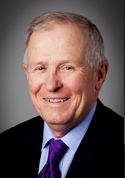© 2013 The Texas Lawbook.
By Mark Curriden and Natalie Posgate
Writers for The Texas Lawbook
As the economy faltered, revenue slowed, gas prices marched north and labor strife increased, American Airlines General Counsel Gary Kennedy eyed few long-term options. Bankruptcy or a merger topped the list.

That was exactly a decade ago.
“I was GC in 2003 when we were very close to bankruptcy and by close, I mean, we were almost on the courthouse steps,” says Kennedy, who has been a lawyer with the Fort Worth-based airline for 29 years. “For 10 years, we gave the good fight.”
As Thanksgiving 2011 approached, Kennedy was experiencing déjà vu. The debt and financial losses were too big. The labor costs were too substantial. The industry had witnessed significant consolidation.
“The time was right and I fully advocated filing [for restructuring],” he says.
Kennedy and his team of in-house and outside lawyers authored what several legal experts agree is one of the most legally complex and sophisticated merger agreements in history – an $11 billion agreement that combines bankrupt American Airlines with US Airways.
The merger agreement also serves as a bankruptcy exit plan that appears to satisfy even disgruntled parties in the Chapter 11 litigation – an outcome that American Airlines officials didn’t believe was possible just a few months ago.
For the past 15 months, Kennedy and his lawyers attended thousands of hours of meetings and court proceedings. They negotiated simultaneously in New York, Phoenix and Dallas with lawyers for bankers, investors, creditors, shareholders, stakeholders, pilots, flight attendants and, of course, officials at US Airways – all of them realizing that their end product would be flyspecked by the bankruptcy judge and federal regulators.
“We took a difficult set of circumstances going into bankruptcy and we made them much more complex and challenging,” says Kennedy. “This has been the most intense, grueling project in my 32 years of practicing law. We’ve worked seven days a week, sometimes around the clock.
“It’s also why my wife has been telling all of our friends that I’ve been so grouchy,” he says.
The decision to file Chapter 11 bankruptcy, which allows companies to reorganize and restructure under various court-approved protections from creditors, didn’t happen “until almost the last minute” in November 2011, according to Thomas Roberts, a partner at Weil, Gotshal & Manges, which Kennedy tapped to be the lead outside counsel for the case.

Lawyers in-house at American and at Weil, which is widely regarded as the nation’s most prominent – and possibly most expensive – bankruptcy practice, were informed of the decision to prepare to file for bankruptcy only days before Thanksgiving. They were told they would need to work through the holiday, but they could not give even a hint to family members about the matters on which they were working.
Having selected Weil as its lead lawyers, Kennedy’s next decision was where to file: Fort Worth or the Southern District of New York.
“We gave great consideration to venue and it was my determination that we file in the Southern District because the judges there have the experience and expertise in these highly complex kind of matters,” says Kennedy.
In an ironic twist, the AMR bankruptcy was assigned to U.S. Bankruptcy Judge Sean Lane, a federal government tax lawyer who was new to the bench and had never handled such a big case.
Lawyers say that Kennedy seemed to be omnipresent at meetings, including court hearings in New York.
Kennedy says he didn’t accumulate any Advantage miles for his many trips to New York, but “I may have to pay New York state taxes given the amount of time I spent in New York.”
Phase one of the bankruptcy was to address labor issues and costs in order to “put the company in a position where it was profitable and its business secure,” says Roberts, who also represented AMR in its 2001 acquisition of TWA Airlines for $500 million. He says AMR has been aided by the fact that it has about $4 billion in cash and assets on hand.
Phase two: compare strategic alternatives to operating on its own.
“The company knew consolidation was likely,” says Roberts. “The question was when to do it. Many potential consolidation candidates were thought to be reluctant to engage while AMR was in bankruptcy. And clearly AMR had less bargaining power in bankruptcy than it would have outside of bankruptcy.”
Then came the critical moment in the bankruptcy that eventually determined its outcome: US Air forced its way into the legal proceedings.
“When US Air entered into a proposed labor agreement with our labor groups, that was key,” says Kennedy.
Lawyers for the various stakeholders needed labor’s support for any exit plan – a position echoed by Judge Lane.
Merger discussions “picked up in earnest in November and we’ve basically been going around the clock for the past several weeks,” says Glenn West, who is the managing partner of Weil’s office in Dallas.

Dozens of the nation’s most prominent bankruptcy and M&A lawyers basically lived in a half-dozen conference rooms on the third floor of the Crescent Court Office Towers, where Weil’s Dallas offices are located. Barbeque from Sammy’s and Bob Anderson, as well as Mexican food from Blue Mesa and Daryl’s, was catered in day and night.
“Some issues would grow bigger and then shrink, only to grow bigger again and some issues would come out of left field,” says West, who led the merger talks. “It is an intense deal with lots of moving parts.”
West and Roberts say that six words were repeated over and over during the negotiations: “That has never been done before.”
“What is so unique here is that the surviving company in this merger is the company in bankruptcy,” says West, who notes that has happened only one or two times in history and never in a deal so large.
As a result, West says, the “merger agreement is not binding until the bankruptcy court approves it,” which outside legal experts say may be precedent-setting in such a complex Chapter 11 restructuring.
For example, the agreement imposes “break-up fees” on the parties if they walk away from the deal, but those penalties only apply if the bankruptcy judge gives final approval to the plan.
Another example of the uniqueness of this transaction has to do with the parties agreeing to the deal. Normally, mergers involved one company buying another company. If the companies agree, then it is a done deal.
“But in this agreement, there are additional constituencies, including the unsecured creditors with their own set of issues to negotiate and the ad hoc committee of debt holders,” says West. He also points out that the deal, which must be agreed to by US Airways’ shareholders, must also receive Judge Lane’s approval.
Federal regulators also will have a say, but Roberts and Kennedy believe that any antitrust concerns the government has can be quickly resolved because there are “very few routes that overlap.”
“This was a very complicated case involving a very large and complex iconic company – iconic not just in Dallas, but in the world,” says Roberts. “There was a gigantic legal morass to go through” to reach this agreement.
Roberts says that leaks to the news media was “one of the biggest issues” the lawyers faced in reaching an agreement.
“I have never seen anything which approached it,” says Roberts, who also led Kinder Morgan’s $23 billion acquisition of El Paso Corp. last year. “There were so many people involved either directly, as advisors or committee members, that it was impossible to avoid most things from leaking to the press, frequently inaccurately.
“There were constant leakage allegations among the participants,” he says. “The entire process was followed closely by the financial press down to discussing everything from food eaten to clothing worn to an occasional bit of information relevant to the process. Information was frequently exchanged by the parties with a restriction that it could only be reviewed by advisors, not principals or clients, but that often was ineffective as well.
“Fortunately, at the end, several key meetings never leaked,” he says. “Anyone really interested in those meetings will have to wait for the proxy statement.”
Roberts says his team at Weil has worked more than 75,000 hours on the bankruptcy and the merger. Bankruptcy court records show that the firm has charged more than $57 million in legal fees and expenses so far.
Overall, AMR has spent more than $172 million in legal fees and legal expenses since it filed Chapter 11. A small fraction of that is to pay for legal disputes unrelated to the bankruptcy or the merger.
Debevoise & Plimpton, another New York firm representing AMR, has billed $32.9 million.
Weil and Debevoise have lawyers charging more than $1,000 an hour, but the highest earning lawyers on the case continue to be from creditor’s counsel Skadden, Arps, Slate Meagher & Flom, a New York firm that has three attorneys charging $1,150 an hour.
“It’s certainly been more expensive than I anticipated, but it also has taken longer and [has been] more complicated than I thought,” says Kennedy.
At the end of the day, Kennedy says he believes AMR has gotten what it has paid for.
“Tom Roberts – that guy is one of the most dedicated lawyers I know and he works tirelessly,” says Kennedy. “I got emails from him at 4 a.m. Tom and Glenn and the entire Weil team have done an amazing job.”
The in-house lawyers who are playing prominent roles in the bankruptcy and merger include Kennedy, AMR Corporate Secretary Kenneth Wimberly, and associate general counsels Tim Skipworth, Kathryn Koorenny and David Allen.
Roberts and West led a team of Weil lawyers from Texas that included corporate finance and restructuring partners Alfredo Pérez in Houston and Stephen Youngman in Dallas, as well as Dallas corporate associates Brett Thorstad, David Gail and Dilen Kumar.
Former Weil corporate securities partner Mary Korby, who is now a partner at K&L Gates in Dallas, also is playing a significant role in the representation of AMR.
© 2013 The Texas Lawbook. Content of The Texas Lawbook is controlled and protected by specific licensing agreements with our subscribers and under federal copyright laws. Any distribution of this content without the consent of The Texas Lawbook is prohibited.
If you see any inaccuracy in any article in The Texas Lawbook, please contact us. Our goal is content that is 100% true and accurate. Thank you.
